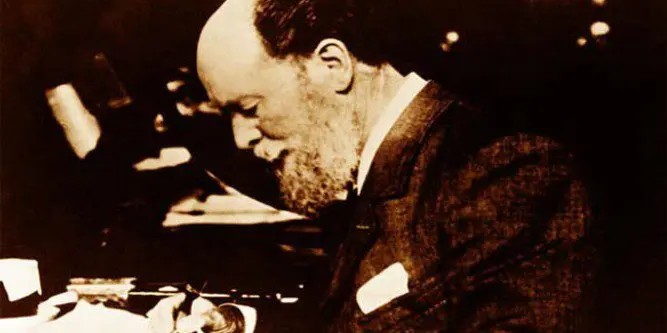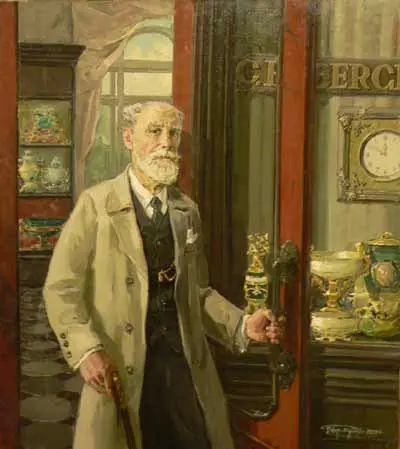
😉 Welcome new and regular readers! The article “Carl Faberge: Biography of the Great Jeweler” contains a short biography and facts from the life of the famous master.
Peter Carl Faberge
Friends, in my youth I first heard about Carl Faberge. Thought he was French. In Soviet times, his name was not mentioned very often. Much later, to my surprise, I learned that the world famous jeweler is ours! He was born, lived and worked in St. Petersburg. Dossier:
- full name – Peter Carl Faberge;
- date of birth – May 30, 1846;
- Gemini;
- place of birth: St. Petersburg, Russian Empire;
- date of death – September 24, 1920 (74 years old);
- place of death – Lausanne, Switzerland;
- occupation: jeweler;
- father – Gustav Faberge. Mother – Charlotte Jungstedt;
- sons: Eugene, Agathon, Alexander, Nikolay.
His father Gustav came from a German family of French roots. He was a modest jeweler who had had his own business since 1841. His mother, Charlotte Jungstedt, was the daughter of a Danish artist.

Peter Carl Faberge
Success story
When Karl was 14 years old, the family moved to Dresden. From there, the father sends his son on a trip to Europe. He stays for a long time in Frankfurt am Main. There he begins to master the jewelry business. The journey then continues to Florence and Paris.
After returning to Russia, at the age of 24, he took over his father’s jewelry company. From a small jewelry workshop, it quickly becomes the largest enterprise in St. Petersburg with several branches. In Moscow since 1887, Odessa (1890), London (1903) and Kiev (1905).
Faberge Jr. tirelessly studies all the techniques known in jewelry, visits museums and libraries. He does not miss a single art exhibition and gets acquainted with young talents everywhere.
He was distinguished by a rare ability to find talents, to convince them of moving to a distant and mysterious Petersburg, and then to create conditions under which they could fully reveal themselves.
In 1870 the staff of the company already totals 100 people (later it grows to 500). The unsurpassed Faberge remained the main source of ideas and the judge of embodied ideas, always and under any conditions.
The personal merit of the successful company was the widespread use in practice of domestic ornamental gemstones, which were previously considered “non-jewelry”. Altai, Ural, Transbaikal gems are boldly combined with precious metals and stones.
Supplier of the Supreme Court
The first overwhelming success came in 1882. At the All-Russian Art and Industry Exhibition in Moscow, the company’s products received a gold medal. A year later, the master receives orders from the yard. Faberge soon begins to be called “Supplier of the Imperial Court” with the right to have the image of the State Emblem on the signboard.
Carl Faberge and the talented craftsmen of his company created the first jewelry egg in 1885. It was ordered by Tsar Alexander III as an Easter surprise for his wife Maria Feodorovna.
The empress was so delighted with the gift that the ingenious master, who turned into a court jeweler, received an order to make an egg every year. Each piece had to be unique and contain some kind of surprise. This was the only condition.
The next emperor, Nicholas II, kept this tradition. Each egg was a unique world masterpiece.
At the 1900 World’s Fair in Paris, Karl wins the “Grand Prix”. The French government awards him the Legion of Honor.
The company’s fame grew like a snowball. Courts of Europe, primarily England, eastern monarchs, large industrialists, financiers and other celebrities, become its customers.
The range of manufactured products was extremely wide. In addition to jewelry, watches, snuff boxes, cigarette cases, souvenirs, sets, silverware, boxes and miniature sculptural toys were made.
Far from home
But here the October Revolution of 1917 made its own adjustments. The Faberge House was closed in November 1918. Miraculously, and only with the help of the British government, the owner manages to emigrate abroad. First to Germany, and then to Switzerland.
But there was no longer the strength to raise everything anew, and there was not enough money either. In 1920, Peter Carl Faberge dies in poverty, far from his homeland and his creations. Together with his death, the brilliant era of Faberge also ends.
In this video more information “Carl Faberge: Biography”
Friends, if you find the article “Carl Faberge: the biography of a great jeweler” interesting – share it in social media. networks. 🙂 Thank you! Visit the site for new stories!









